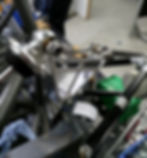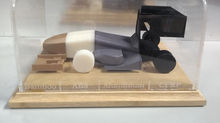HEADS DOWN, THE BUILD IS ON...
This week sees the end of the academic year for all of SHU Racing's student members, which only means one thing... its building time! With the charge through to July on, the team now has the task of bringing all the car's components together and setting sites on an initial shake down. Read on to find out about the past fortnight's developments as the younger years lead the build.
BRILLIANT BG ENGINEERING
As we bring the cars components together and enter the rolling chassis phase, one of the team's top sponsors, BG Engineering, bring their expert machining contribution to the car's progress. Tasked with machining a suite of components, SHU Racing worked with the machining team at BG Engineering to simplify parts, making them fit in easier with the outfits manufacturing capacity. This type of part alteration translates into a much more available component when applying it to the commercial viability of the car, a factor the team's engineers have to consider and present to the judges at FS UK.

Included in the component listing are the team's new computationally verified brake disks, water jet cut from 420 Stainless steel and faced off to ensure precise running within the wheel assembly. Following feedback from 2018's designers and the judges at Silverstone, the team knew they had to perform thermal analysis on the brake disc to show their appropriateness for the race conditions. The finalised design included 184 face holes, all their to serve the purpose of heat dissipation, good braking performance and low rotational mass.

This year's suspension bell cranks, or 'rockers', have also come machined from BG Engineering. The new 2019 rockers move away form Titanium used previously, relying on more representable load path analysis to allow the use of 7000 series aluminium, a more commercially available grade. Pairing with precision needle roller bearings from SCHAEFFLER, the front and rear rockers are designed as mono-piece components and utilise simply machined additional parts which ensure the rockers rotate freely regardless of the clamping force.

The final piece of machining is the newly designed injector housing, set to replace the historically used OEM component direct from the standard KTM Engine. The simplified part removes unnecessary features from the stock unit whilst retaining crucial geometry to ensure air flow into the unit and fuel injection is consistent with the original part.

SHU Racing would like to thank BG Engineering for their continued commitment to the team and the Engineering field, and look forward to representing their brand at FSUK 2019.
WHEELS ROLLING
With all in-wheel components machined and ready, the WHUBS (Wheel, Hubs, Uprights and Brakes) manager, Samuel Seabrooke, had the chance to assemble the front and rear units and contribute his technical section to the progression towards a rolling car.
The part-topologicaly optimised Uprights, machined in-house from 7050 Aluminium, focus on Design for Assembly (DfA) and overall assembly simplicity. The 50% reduced part count within the entire assembly has reduced the per-corner mass by 0.963kg, a vital saving when considering the reactive performance of the mating suspension and wheel systems.


Once again applying Schaeffler's precision bearings, the new assemblies use rubber sealed Angular contact bearings, reducing mass and improving service life of the rotational system.
TESTING TO FATIGUE
To enable the new mono-piece Uprights, the wishbone suspension system required a new method of adjustment so that the vehicle's handling characteristics can be set up to suit the track. With any new system type, verification is required to assess its structural performance and behaviour under average and peak loads.
Using Sheffield Hallam's testing facilities, the lower wishbone structure was set up to simulate behaviour under both peak braking load and more crucially to vehicle handling, deflections under cornering. Subjecting the system to fully reversed bending, R= -1, the load case was simultaneously submitted to forces experienced as if the vehicle was manoeuvring left and right corners. The peak brake force simulates the suitability to withstand the loads experienced under an emergency stopping manoeuvre.

Having clocked up the cycles and ultimately subjected the structure to failure, all parameters of the system performed exemplary, deflecting at rates within 5% of the values simulated in computational analysis and only failing at a load 4x the theoretical maximum.
It is this type of testing that the team aim to amplify when being judged by the Engineering Scrutineers come FSUK 2019.




















